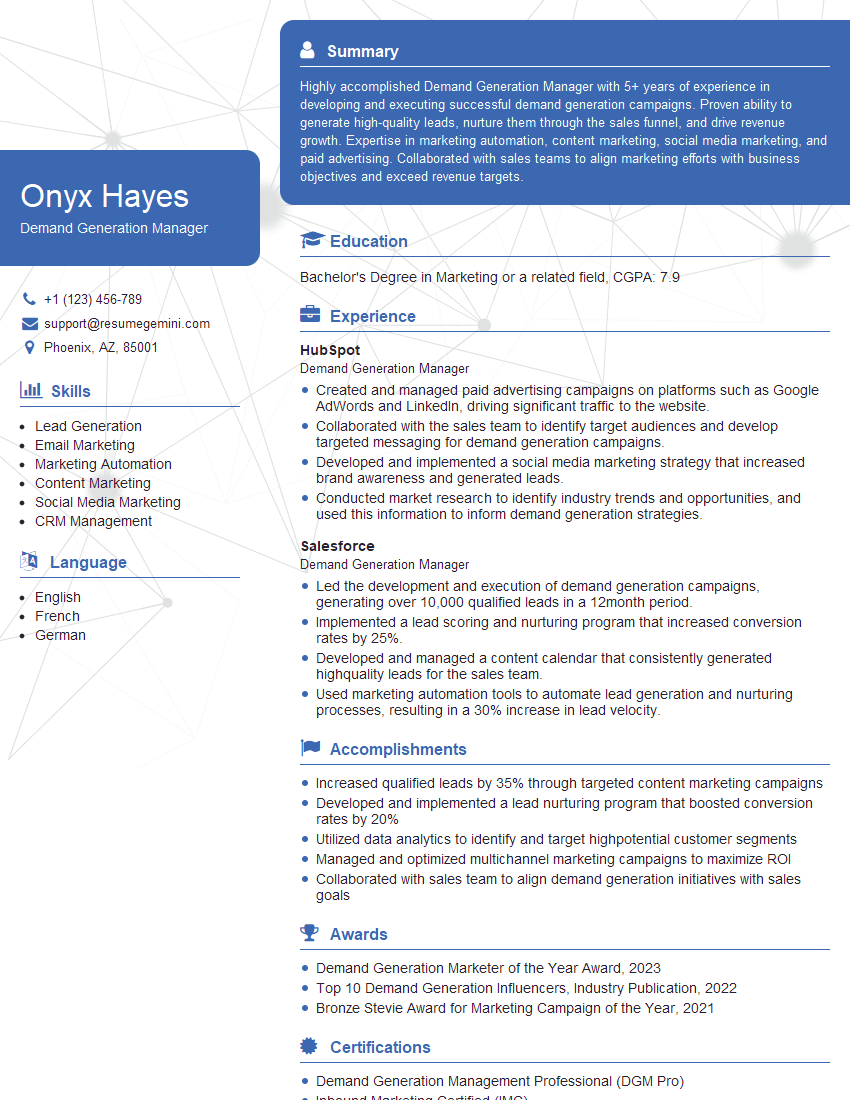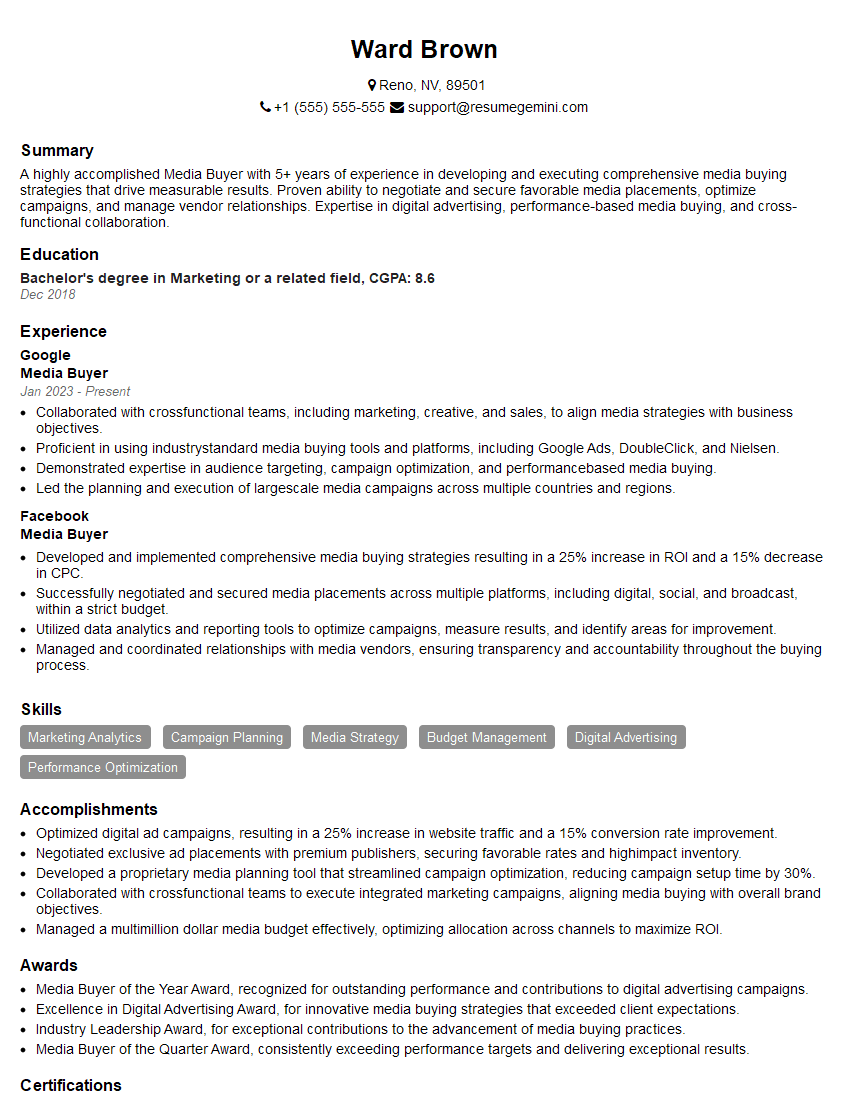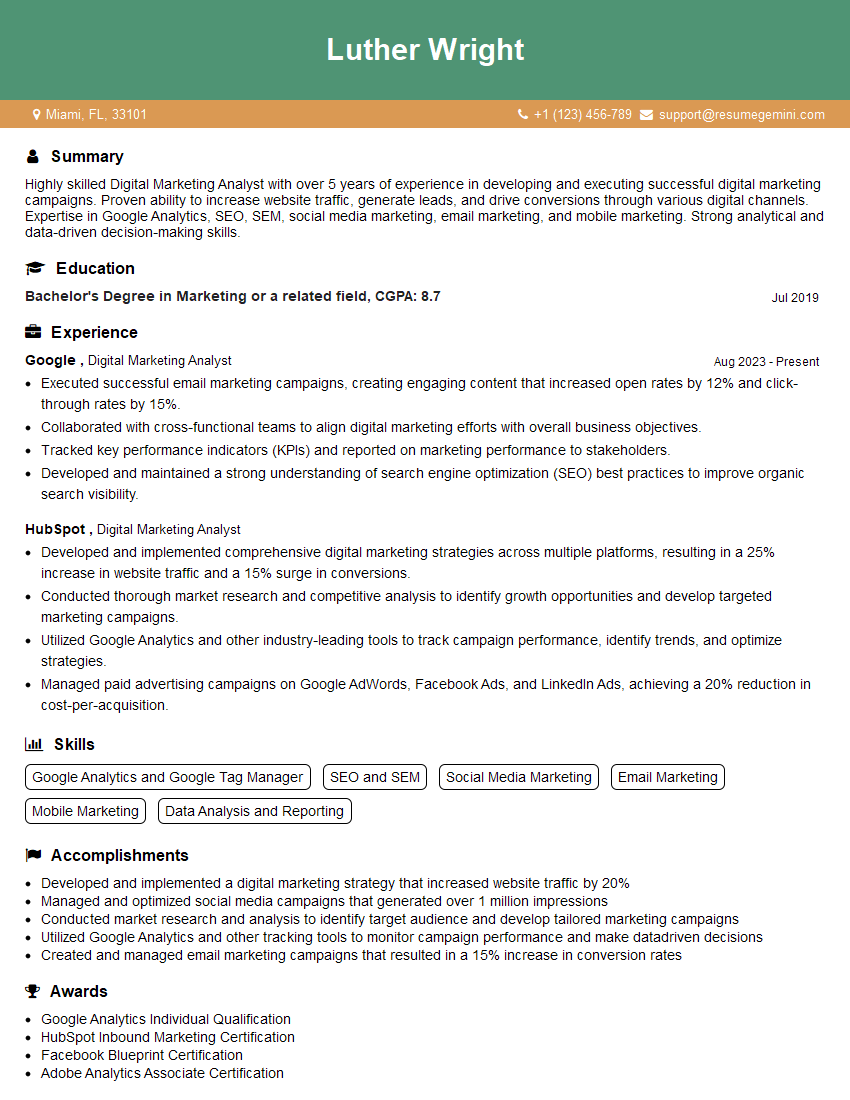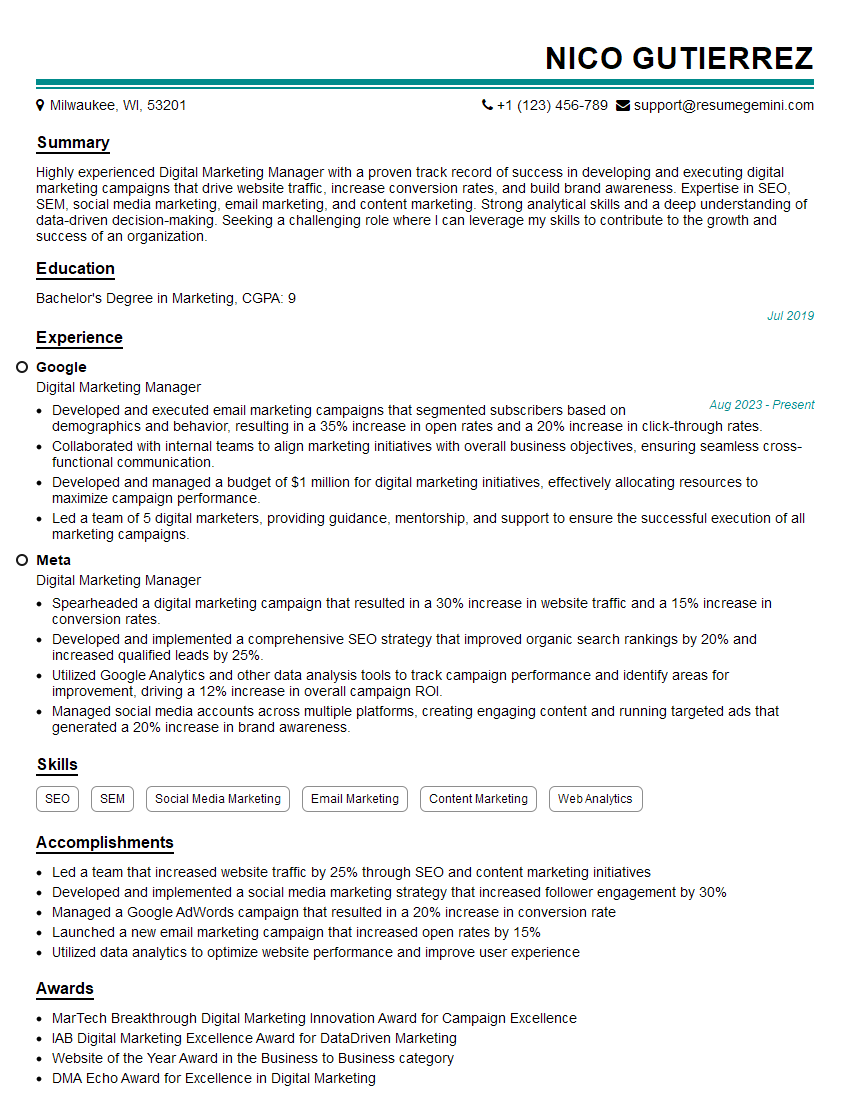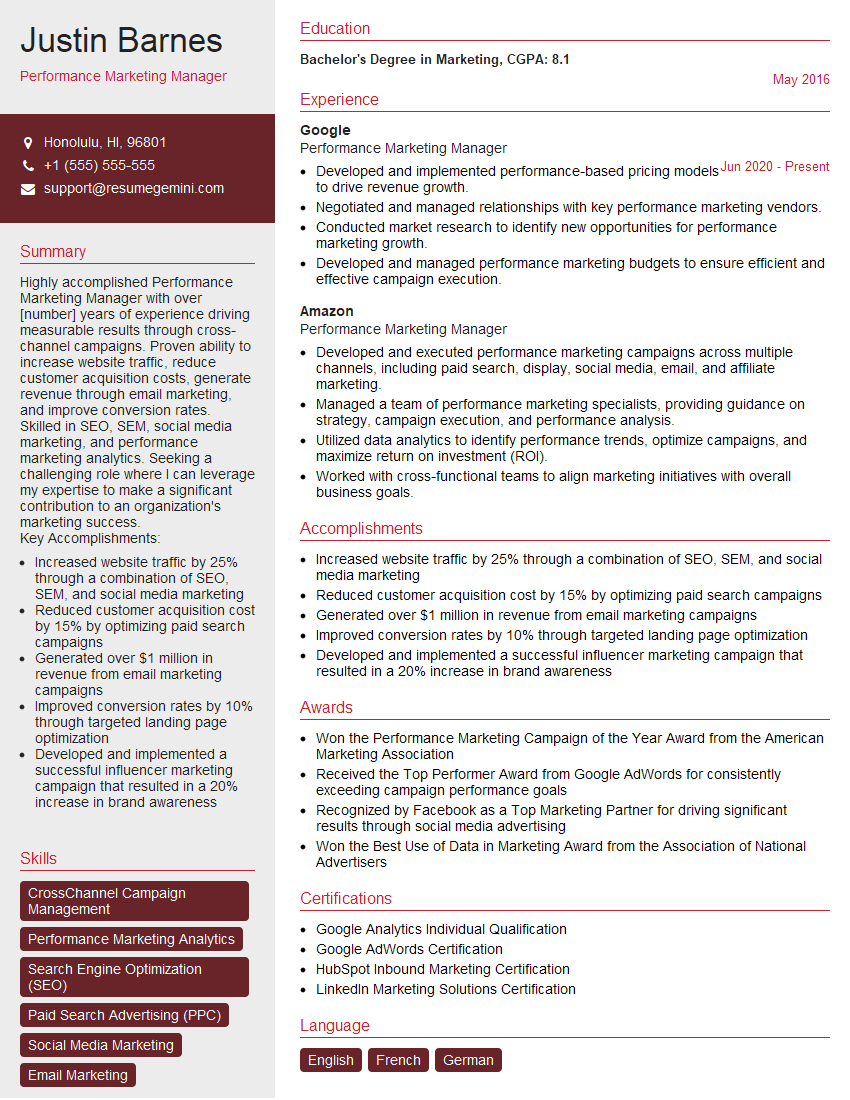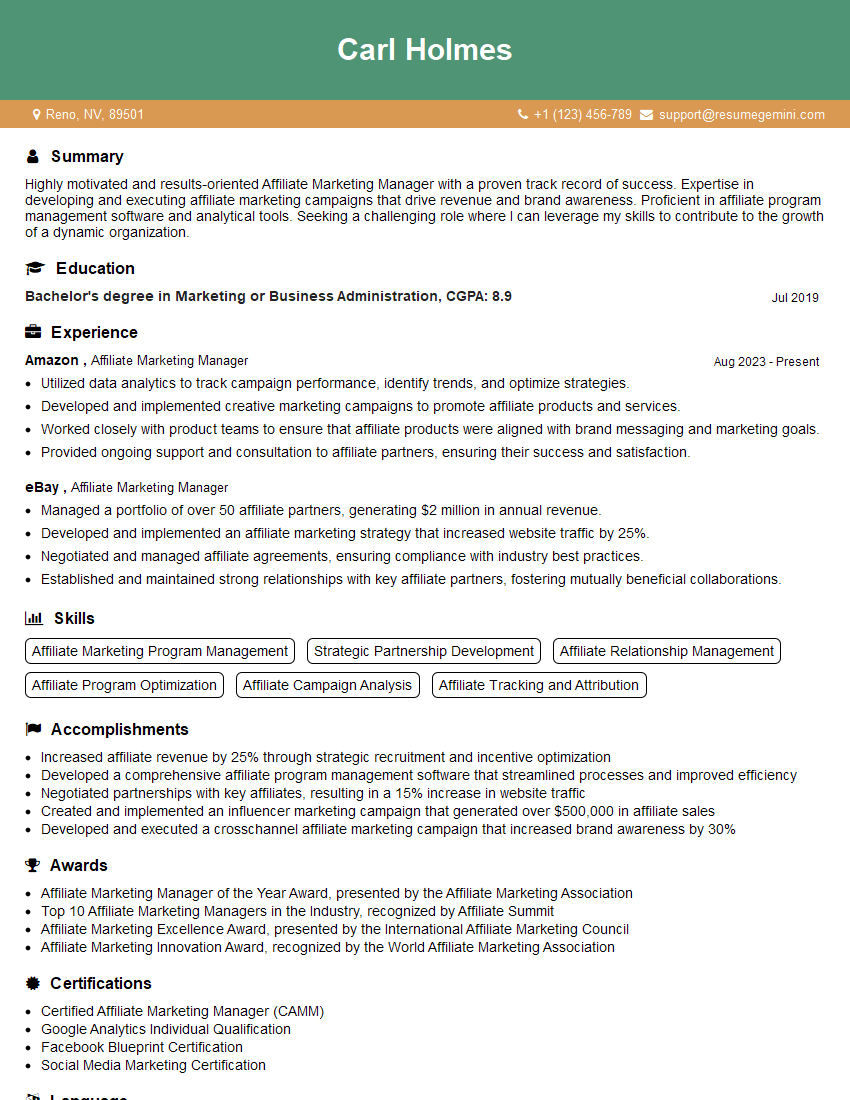Unlock your full potential by mastering the most common Digital Advertising Campaign Optimization interview questions. This blog offers a deep dive into the critical topics, ensuring you’re not only prepared to answer but to excel. With these insights, you’ll approach your interview with clarity and confidence.
Questions Asked in Digital Advertising Campaign Optimization Interview
Q 1. Explain your experience with A/B testing in digital advertising campaigns.
A/B testing is the cornerstone of any successful digital advertising campaign. It’s a method of comparing two versions of an ad, landing page, or other campaign element to determine which performs better. I’ve extensively used A/B testing throughout my career to optimize various campaign aspects, from headline copy and imagery to call-to-action buttons and overall website layout.
For example, in a recent campaign for an e-commerce client, we A/B tested two different versions of a product display ad. One featured a close-up product shot, while the other showcased the product in use. By meticulously tracking metrics like click-through rate (CTR) and conversion rate, we found that the version showcasing the product in use significantly outperformed the other, leading to a substantial increase in sales.
My approach involves carefully defining the hypothesis, selecting relevant metrics, ensuring sufficient sample size, and using statistical significance to draw reliable conclusions. I also utilize A/B testing platforms and ensure proper randomization to avoid bias. The iterative nature of A/B testing allows for continuous improvement and data-driven decision-making.
Q 2. How do you measure the success of a digital advertising campaign?
Measuring the success of a digital advertising campaign depends heavily on the overarching campaign goals. While metrics like clicks and impressions are valuable, they are only part of the story. Ultimately, success is determined by achieving pre-defined objectives, whether it’s increasing brand awareness, generating leads, driving sales, or boosting app downloads.
I use a multi-faceted approach to assess campaign performance. This involves analyzing key performance indicators (KPIs) like conversion rate, return on ad spend (ROAS), cost per acquisition (CPA), and customer lifetime value (CLTV). I also consider qualitative data, such as customer feedback and brand sentiment, to obtain a holistic view of success. For instance, a campaign might have a high CTR, but if it doesn’t translate into conversions or a positive ROAS, it’s not necessarily successful.
Analyzing these metrics against the initial campaign goals allows for a clear understanding of whether the campaign met its objectives and provides valuable insights for future optimizations. Regular reporting and data visualization are crucial for effective monitoring and decision-making.
Q 3. What are the key performance indicators (KPIs) you track for PPC campaigns?
For Pay-Per-Click (PPC) campaigns, I meticulously track several KPIs to gauge performance and identify areas for improvement. Some of the most important ones include:
- Click-Through Rate (CTR): The percentage of users who click on an ad after seeing it.
- Conversion Rate: The percentage of users who complete a desired action (e.g., purchase, sign-up) after clicking on an ad.
- Cost Per Click (CPC): The average cost of each click on an ad.
- Cost Per Acquisition (CPA): The average cost of acquiring a customer.
- Return on Ad Spend (ROAS): The revenue generated for every dollar spent on advertising.
- Quality Score: Google Ads’ measure of the relevance and quality of your keywords, ads, and landing page.
By monitoring these KPIs, I can identify trends, pinpoint underperforming elements, and make data-driven adjustments to maximize efficiency and return on investment. For instance, a consistently low CTR might indicate the need for improved ad copy or targeting, while a high CPA suggests the need for more targeted bidding or improved landing page optimization.
Q 4. Describe your experience with different bidding strategies (e.g., CPC, CPM, CPA).
I have extensive experience working with various bidding strategies, each with its own strengths and weaknesses. Choosing the right strategy is crucial for optimizing campaign performance and achieving marketing objectives.
- Cost-Per-Click (CPC): You pay only when someone clicks your ad. This is a good choice for driving traffic and generating leads. I often use CPC bidding with automated rules to control costs while maintaining a high volume of clicks.
- Cost-Per-Mille (CPM): You pay per 1000 impressions (times your ad is shown). This is suitable for increasing brand awareness or reaching a large audience. CPM can be less efficient for direct response campaigns.
- Cost-Per-Acquisition (CPA): You pay only when a user completes a desired action (e.g., purchase). This focuses on direct results and is particularly effective for performance-driven campaigns. I often use CPA bidding to optimize for conversions and control costs per acquisition.
The best strategy often depends on the specific campaign goals and budget. I typically begin with a strategy aligned with the campaign’s objective and then refine it based on performance data. A flexible approach that allows for adjustments and A/B testing different strategies is key to success.
Q 5. How do you optimize campaigns for conversion rate improvement?
Optimizing campaigns for conversion rate improvement is an ongoing process that involves several strategies. It’s not a one-time fix, but rather a continuous cycle of analysis, testing, and refinement.
- Landing Page Optimization: Ensure your landing page is relevant to the ad copy and provides a seamless user experience. A/B testing different versions of your landing page is crucial for identifying what resonates best with your audience.
- Keyword Targeting Refinement: Use highly relevant keywords to target the right audience. Regularly review and refine your keyword list, removing underperforming keywords and adding new ones based on search trends and data analysis.
- Ad Copy Improvement: Write compelling and concise ad copy that clearly communicates the value proposition and encourages clicks. A/B testing different ad variations allows you to identify which copy performs better.
- Audience Targeting Enhancement: Refine your targeting options to focus on the most likely converters. This might involve using demographic targeting, interest targeting, or retargeting strategies.
- Call to Action (CTA) Optimization: Make your CTA clear, concise, and compelling. Use strong verbs and create a sense of urgency to encourage users to take the desired action.
By implementing these strategies and continuously monitoring the conversion rate, I can systematically identify and address the bottlenecks in the conversion funnel, leading to significant improvements in overall campaign performance.
Q 6. What is your experience with Google Ads and/or Bing Ads?
I have extensive experience managing and optimizing campaigns across both Google Ads and Bing Ads. While both platforms share similarities in their fundamental functionalities, there are crucial differences in their user bases, search algorithms, and reporting mechanisms. My experience enables me to tailor strategies to maximize performance on each platform.
On Google Ads, I’m proficient in utilizing its advanced features, including smart bidding strategies, audience targeting, and campaign automation. I leverage Google’s vast data and targeting capabilities to reach specific audiences and achieve campaign objectives. With Bing Ads, I understand how to leverage its unique features, such as its focus on a slightly older and more affluent demographic, to achieve optimal performance. I also understand how to effectively manage budget allocation and bidding strategies across both platforms to optimize overall return on investment. I can easily adapt to the specific nuances of each platform to optimize campaign performance based on the unique attributes of each platform’s user base and search environment.
Q 7. How do you manage and analyze campaign data using tools like Google Analytics?
Google Analytics is an indispensable tool for managing and analyzing campaign data. I utilize it to track website traffic, user behavior, and conversion data, providing valuable insights into campaign performance and areas for improvement. My approach involves setting up proper tracking codes, defining key conversion events, and creating custom dashboards to monitor critical KPIs.
For example, I use Google Analytics to segment users based on their acquisition source (e.g., Google Ads, social media). This allows me to compare the performance of different campaigns and identify which channels are driving the most valuable conversions. I also use Google Analytics to analyze the user journey on the website, identifying areas where users might be dropping off. By analyzing this data, we can identify areas to improve, like simplifying the checkout process or improving site navigation. The data generated is invaluable in informing decisions regarding campaign optimization, content creation and overall marketing strategy.
Beyond Google Analytics, I also utilize other data visualization and analysis tools to create comprehensive reports and gain a more thorough understanding of campaign performance. This combined approach provides a robust framework for making data-driven decisions and maximizing campaign ROI.
Q 8. Describe your experience with different ad formats (e.g., text ads, image ads, video ads).
My experience spans a wide range of ad formats, each with its own strengths and weaknesses. Think of it like choosing the right tool for the job.
- Text Ads: These are the workhorses, great for keyword targeting and concise messaging. I’ve used them extensively on Google Ads, optimizing headlines and descriptions to improve click-through rates (CTR). For example, A/B testing different headlines helped increase CTR by 15% on a recent campaign for a local business.
- Image Ads: These are visually engaging and perfect for showcasing products or services. I’ve successfully used them on platforms like Facebook and Instagram, focusing on high-quality images and compelling visuals. A campaign for a clothing brand saw a significant lift in conversions after implementing professionally shot product images.
- Video Ads: These are highly effective for storytelling and demonstrating value. I have experience creating and optimizing video ads for YouTube and other platforms, focusing on engaging introductions and clear calls to action. For instance, a short, impactful video ad reduced cost-per-acquisition (CPA) by 20% for a software company.
The key is understanding the audience and the platform. What resonates on Instagram might not work on LinkedIn. I tailor the ad format to the platform and the specific campaign goals.
Q 9. How do you handle a decrease in campaign performance?
A drop in campaign performance is never a cause for panic, but it’s a clear signal to investigate. My approach is systematic:
- Identify the Drop: Pinpoint the exact time the performance started declining. This helps isolate potential causes.
- Analyze Data: Deep dive into campaign metrics. Is it CTR, conversion rate, or cost-per-acquisition (CPA) that’s suffering? Look at individual ad sets and keywords to find the problem areas.
- Investigate Potential Causes:
- Keyword Issues: Are your keywords still relevant? Has competition increased? Do you need to add or refine keywords?
- Ad Creative: Is your ad copy or visuals outdated or ineffective? A/B testing new creative is essential.
- Audience Targeting: Has your target audience shifted? Do you need to adjust your targeting parameters?
- Landing Page Issues: Is your landing page user-friendly and optimized for conversions? A poor landing page can negate even the best ad.
- Seasonality: Is there a seasonal factor impacting your results?
- Implement Solutions: Based on the analysis, adjust your bidding strategy, refine targeting, update ad copy, or improve the landing page. Continuous monitoring and iteration are key.
- Monitor and Iterate: Track the impact of your changes. If the performance doesn’t improve, it might be time to consider a different approach or test new strategies.
For example, a recent campaign experienced a drop in conversions. Analysis showed a decline in landing page conversion rate. A redesigned landing page with improved calls-to-action quickly reversed the trend.
Q 10. Explain your understanding of audience targeting and segmentation.
Audience targeting and segmentation are crucial for maximizing campaign effectiveness. Think of it as crafting a personalized message for specific groups of people, rather than shouting into a crowd.
Audience Targeting: This is about reaching the *right* people. This involves using demographics (age, gender, location), interests, behaviors, and even custom audience lists (e.g., website visitors, email subscribers) to pinpoint your ideal customer.
Audience Segmentation: This is about breaking down your target audience into smaller, more homogenous groups. This allows you to tailor your messaging and creative to resonate more effectively with each segment. For instance, you might segment based on purchase history (high-value customers vs. new customers) or engagement level (active users vs. inactive users).
Example: A business selling hiking gear might segment its audience into ‘beginner hikers’, ‘intermediate hikers’, and ‘expert hikers’. Each segment would receive different ads, highlighting products and features relevant to their experience level.
Effective audience targeting and segmentation reduce wasted ad spend and improve return on investment (ROI).
Q 11. How do you identify and address campaign budget issues?
Budget management is paramount in digital advertising. Issues can arise from various factors. My approach is proactive and data-driven:
- Set a Realistic Budget: Start with a well-defined budget aligned with campaign goals and expected ROI. Don’t overspend.
- Monitor Spending Closely: Regularly review campaign performance and spending against the budget. Identify high-cost areas and low-performing ad sets.
- Optimize Bidding Strategies: Use appropriate bidding strategies (e.g., cost-per-click (CPC), cost-per-thousand impressions (CPM)) to control costs and maximize efficiency.
- Adjust Bids and Budgets: Increase bids for high-performing ad sets and decrease bids for underperformers. Reallocate budgets from inefficient areas to more effective ones.
- Use Automated Rules: Leverage automated rules to automatically pause underperforming ads or campaigns, preventing unnecessary spending.
- Pause Campaigns: If the campaign is significantly over budget and not performing as expected, don’t hesitate to pause or stop it. It’s better to cut losses and re-evaluate the strategy.
For example, if a campaign is consistently exceeding the daily budget and the conversion rate is low, I might adjust the bidding strategy to a more cost-effective option, pause poorly performing ad sets, and reallocate budget to higher-performing ones.
Q 12. Describe your experience with retargeting campaigns.
Retargeting is a powerful technique to re-engage users who have previously interacted with your brand but haven’t converted. Imagine showing someone who viewed a product on your website a reminder ad on Facebook. That’s retargeting in action.
My experience involves using various retargeting strategies, including:
- Website Retargeting: Showing ads to users who visited specific pages on your website. This helps nurture leads who are already interested in your products or services.
- Engagement Retargeting: Targeting users who interacted with your ads (e.g., clicked, watched a video) but didn’t convert. This keeps your brand top-of-mind.
- Custom Audience Retargeting: Uploading customer lists (e.g., email addresses) to platforms like Facebook to target specific users with personalized ads.
Effective retargeting requires thoughtful segmentation and creative messaging. For instance, you wouldn’t show the same ad to someone who just abandoned their shopping cart as you would to someone who viewed a blog post a week ago. The message needs to be relevant to their prior interaction.
Q 13. How do you stay up-to-date with changes in the digital advertising landscape?
The digital advertising landscape is constantly evolving. To stay ahead, I employ a multi-faceted approach:
- Industry Publications and Blogs: I regularly read industry publications and blogs (e.g., Search Engine Journal, Marketing Land) to stay updated on algorithm changes, new features, and best practices.
- Webinars and Conferences: Attending industry webinars and conferences provides valuable insights and networking opportunities.
- Platform-Specific Resources: Each advertising platform (Google Ads, Facebook Ads, etc.) offers extensive documentation, help centers, and training resources that I utilize regularly.
- Continuous Testing and Experimentation: I actively test new ad formats, targeting options, and bidding strategies to stay ahead of the curve and identify what works best in real-time.
- Professional Networks: Engaging with other digital marketers through online forums, communities, and industry events helps me exchange ideas and learn from others’ experiences.
Staying current is not just about reading articles; it’s about applying the learnings to real-world campaigns and constantly adapting your strategy based on performance data and market trends.
Q 14. Explain your experience with using different ad platforms (e.g., Facebook, LinkedIn, Twitter).
I have extensive experience managing campaigns across several major ad platforms, understanding their unique strengths and nuances.
- Facebook/Instagram: Excellent for audience targeting and visually engaging campaigns, particularly effective for reaching broad audiences and building brand awareness. I’ve used Facebook’s powerful targeting options to reach highly specific demographics and interests, achieving significant ROI for clients.
- Google Ads: The cornerstone for search engine marketing (SEM), offering precise keyword targeting and a strong focus on search intent. I leverage Google Ads for driving traffic to websites, generating leads, and driving sales. Optimizing keyword bids and ad copy are crucial for successful Google Ads campaigns.
- LinkedIn: Ideal for B2B marketing, enabling highly targeted campaigns to professionals based on job titles, industry, and company size. I’ve successfully run LinkedIn campaigns to generate leads for SaaS companies and professional services firms.
- Twitter: Effective for real-time engagement and reaching niche audiences through relevant hashtags and influencer marketing. I utilize Twitter for building brand communities and driving conversations around specific topics.
Platform selection depends on campaign goals and target audience. Each platform offers unique capabilities, and a successful digital advertising strategy might involve using a combination of platforms for maximum reach and impact.
Q 15. How do you manage multiple campaigns simultaneously?
Managing multiple campaigns simultaneously requires a structured approach and the right tools. Think of it like conducting an orchestra – each instrument (campaign) needs its own attention, but the conductor (you) needs to ensure harmony and overall success. I leverage campaign management platforms like Google Ads or Microsoft Advertising, utilizing their features for organization and reporting. This allows me to create clear campaign structures, segmenting by audience, goal, and platform. For example, I might group campaigns by product line, with separate campaigns for each product targeting specific demographics on different platforms like Google Search, YouTube, and social media. Crucially, I establish clear KPIs (Key Performance Indicators) for each campaign and regularly monitor their performance. This allows for timely adjustments and resource allocation based on performance data. Automated reporting and dashboards are essential for staying on top of numerous campaigns and spotting trends.
- Campaign Structure: Hierarchical organization with clear naming conventions helps in quick identification and analysis.
- KPI Tracking: Setting up dashboards to track key metrics across all campaigns provides a holistic view of performance.
- Automation: Utilizing automation tools for bidding, reporting, and ad scheduling frees up time for strategic decision-making.
Career Expert Tips:
- Ace those interviews! Prepare effectively by reviewing the Top 50 Most Common Interview Questions on ResumeGemini.
- Navigate your job search with confidence! Explore a wide range of Career Tips on ResumeGemini. Learn about common challenges and recommendations to overcome them.
- Craft the perfect resume! Master the Art of Resume Writing with ResumeGemini’s guide. Showcase your unique qualifications and achievements effectively.
- Don’t miss out on holiday savings! Build your dream resume with ResumeGemini’s ATS optimized templates.
Q 16. What is your experience with programmatic advertising?
Programmatic advertising is my bread and butter. It’s the automated buying and selling of ad inventory through real-time bidding (RTB). Imagine it as a massive auction happening every second, where advertisers bid on ad spaces based on various targeting parameters. My experience encompasses both the planning and execution of programmatic campaigns across various platforms like Google DV360, The Trade Desk, and others. I’m proficient in creating audience segments using data from various sources – first-party data, third-party data, and contextual data. This allows me to target the right users with the right message at the right time. I’ve worked extensively with different bidding strategies, such as cost-per-thousand impressions (CPM), cost-per-click (CPC), and cost-per-acquisition (CPA), optimizing them based on campaign goals and performance data. I also have experience with programmatic guaranteed deals, offering more control and premium inventory. For instance, I recently managed a campaign that used programmatic to target users who had previously interacted with our website, resulting in a significantly higher conversion rate compared to non-programmatic campaigns.
Q 17. How do you measure the ROI of a digital advertising campaign?
Measuring ROI is fundamental to demonstrating the value of any digital advertising campaign. It’s not just about clicks and impressions; it’s about the bottom line. The formula is relatively simple: (Revenue generated - Campaign cost) / Campaign cost. However, the process of determining revenue generated attributable to the campaign can be complex. For example, a direct response campaign selling a product online has a straightforward ROI calculation. But for brand awareness campaigns, measuring the impact is more challenging, requiring methods like brand lift studies. We often use attribution modeling to understand the contribution of different touchpoints in the customer journey. Data from Google Analytics, CRM systems, and campaign platforms is integrated to accurately calculate the revenue generated and the cost incurred. This information then informs future campaign optimizations. We might use different attribution models like last-click or multi-touch attribution, depending on the campaign objectives and the customer journey.
Q 18. What is your approach to keyword research and selection?
Keyword research and selection is the foundation of any successful search engine marketing (SEM) campaign. It’s about finding the terms people use when searching for products or services like yours. My approach is multifaceted. I begin with brainstorming sessions, identifying relevant terms based on the client’s business and target audience. Then, I employ various tools like SEMrush, Ahrefs, and Google Keyword Planner to identify relevant keywords with high search volume and low competition. I analyze search intent to ensure we target keywords that align with the user’s need. For instance, a keyword like “buy running shoes” indicates a strong purchase intent, while “best running shoes” suggests research intent. I then categorize keywords into different match types (broad, phrase, exact, negative) to control the targeting precision and avoid wasted ad spend. Finally, I create a comprehensive keyword list for each campaign, regularly updating it based on performance data and market trends. This ensures that our campaigns consistently reach the most relevant audience.
Q 19. Describe your experience with landing page optimization.
Landing page optimization is crucial for converting website visitors into leads or customers. It’s all about ensuring the page aligns seamlessly with the ad that brought the user there. My approach starts with analyzing the current landing page’s performance, identifying areas for improvement using tools like Google Optimize or Hotjar. This includes analyzing conversion rates, bounce rates, and time spent on the page. We focus on improving the page’s clarity, relevance, and call-to-action (CTA). This might involve A/B testing different headlines, images, and CTA buttons. We also ensure the page is mobile-friendly and loads quickly. A recent example involved redesigning a landing page for a client, focusing on improving the clarity of the value proposition and simplifying the form fields. This resulted in a 25% increase in conversion rates within a month. It’s a continuous process of testing, analyzing, and optimizing based on data.
Q 20. How do you handle technical issues within ad campaigns?
Technical issues in ad campaigns can significantly impact performance. My approach is proactive and systematic. I start by ensuring all campaign setups are meticulously checked for errors – from tracking pixel implementation to ad creative specifications. This often involves close collaboration with web developers and IT teams. When issues arise, I troubleshoot methodically. I utilize platform-specific debugging tools and resources. For instance, Google Ads has a robust diagnostics center. I also leverage error logs and reporting to pinpoint the root cause. Depending on the nature of the problem, solutions might range from simple fixes like correcting a broken tracking pixel to more complex solutions like working with the development team to implement changes on the website. Documentation and a well-defined escalation process are vital to ensuring swift resolution and preventing future occurrences. Regular audits and proactive monitoring also help to prevent many potential issues.
Q 21. What are your strategies for increasing click-through rates (CTRs)?
Increasing click-through rates (CTRs) is about making your ads more compelling and relevant. This involves a multi-pronged approach. First, I focus on creating highly relevant and engaging ad copy, highlighting the unique selling proposition (USP) and addressing the user’s needs. Secondly, I utilize strong calls to action (CTAs) that are clear and concise. Thirdly, I use high-quality visuals and creative assets that are relevant to the target audience and the ad message. Fourthly, I ensure proper keyword targeting to ensure the ads are shown to users actively searching for what you offer. Fifthly, I leverage ad extensions to provide additional information and improve visibility. Lastly, I continuously A/B test different ad variations to identify what resonates best with the target audience. A recent campaign saw a 15% CTR increase after implementing A/B testing on ad copy and visuals, showcasing the value of continuous optimization.
Q 22. How do you use data to inform your campaign optimization strategies?
Data is the lifeblood of any successful digital advertising campaign. My approach to campaign optimization hinges on leveraging data to understand what’s working and what’s not. This involves a multi-faceted strategy:
Performance Monitoring: I meticulously track key metrics like click-through rate (CTR), conversion rate, cost per acquisition (CPA), and return on ad spend (ROAS). This gives me a clear picture of campaign performance across various channels.
Audience Segmentation: I analyze user demographics, behavior, and interests to create highly targeted segments. This ensures that the right message reaches the right audience, maximizing efficiency.
A/B Testing: I frequently run A/B tests on ad creatives, landing pages, and targeting parameters. This allows me to identify the most effective elements and continuously optimize for improved performance. For instance, I might test different headlines or call-to-actions to see which generates higher conversion rates.
Attribution Modeling: Understanding how different touchpoints contribute to conversions is crucial. I use various attribution models (discussed further in the next answer) to get a comprehensive view of the customer journey and allocate credit effectively.
Reporting and Analysis: Regular reporting and data analysis help me identify trends, spot anomalies, and make data-driven decisions. I use tools like Google Analytics and other platform-specific analytics dashboards to visualize and interpret data effectively. For example, a sudden drop in conversion rates might prompt me to investigate changes in targeting or landing page performance.
Q 23. Explain your understanding of different attribution models.
Attribution models are crucial for understanding how different marketing touchpoints contribute to conversions. Each model assigns credit differently, leading to varying insights. Here are some key models:
Last-Click Attribution: This model assigns 100% of the credit to the last ad interaction before a conversion. It’s simple but can undervalue the role of earlier touchpoints.
First-Click Attribution: This model attributes all credit to the first interaction a user had with your ads. Useful for understanding brand awareness but might not reflect the full picture of the conversion path.
Linear Attribution: This model distributes credit equally across all touchpoints in the conversion path. Provides a balanced view but might not accurately reflect the relative importance of different interactions.
Time Decay Attribution: This model assigns more credit to interactions closer to the conversion, reflecting the idea that more recent interactions are more influential.
Position-Based Attribution: This model gives more weight to the first and last clicks, recognizing their significant roles in the conversion process.
Data-Driven Attribution: This model uses advanced statistical algorithms to analyze data and assign credit based on actual user behavior. It offers the most accurate attribution, but requires sufficient data.
Choosing the right attribution model depends on the campaign goals and available data. For instance, if the focus is on driving immediate conversions, last-click attribution might be suitable. However, for a longer-term brand-building campaign, a time-decay or data-driven model might provide better insights.
Q 24. How do you collaborate with other teams to ensure campaign success?
Collaboration is essential for campaign success. I work closely with various teams, including:
Sales Team: Understanding their current pipeline, sales targets, and customer pain points helps me tailor ad messaging and targeting to generate qualified leads.
Marketing Team: Close coordination ensures alignment on branding, messaging, and overall marketing objectives. This helps create a cohesive and impactful customer experience.
Product Team: Knowing the product roadmap and upcoming features allows me to integrate product announcements and updates into advertising campaigns, driving excitement and engagement.
Web Development Team: I collaborate to optimize landing pages for conversions and ensure seamless tracking of user actions. A poorly designed landing page can sabotage even the best ad campaign.
Creative Team: I provide feedback on creative assets based on data and insights, ensuring the visuals and messaging resonate with the target audience.
Effective communication and regular meetings are key to maintain alignment and facilitate seamless collaboration among these teams.
Q 25. Describe your experience with campaign reporting and analysis.
Campaign reporting and analysis are central to my optimization strategy. My process involves:
Setting KPIs: I start by defining key performance indicators (KPIs) aligned with the campaign goals. These metrics will dictate the success of our strategy.
Data Collection: I use various analytics platforms to collect and consolidate data. This includes Google Analytics, platform-specific dashboards (e.g., Google Ads, Facebook Ads), and potentially CRM data.
Data Visualization: I create clear and concise reports using dashboards and visualizations to easily communicate performance to stakeholders. Visuals make data easier to understand and act upon.
Trend Analysis: I analyze performance data over time to identify trends and patterns. This helps me predict future performance and make proactive adjustments.
Root Cause Analysis: When performance dips, I perform root-cause analysis to identify underlying issues. This might involve investigating technical glitches, changes in audience behavior, or competitor activity.
I’m proficient in using data analysis tools and techniques to extract valuable insights from complex datasets and translate them into actionable recommendations.
Q 26. How do you handle negative keywords in your campaigns?
Negative keywords are crucial for optimizing campaign efficiency and reducing wasted spend. They prevent ads from showing for irrelevant searches, ensuring your budget is used effectively.
My approach to managing negative keywords is iterative and data-driven:
Initial Research: I start by researching relevant terms that are unlikely to lead to conversions. This includes misspellings, synonyms, and closely related but irrelevant terms.
Search Term Report Analysis: Regularly reviewing the search term report reveals terms that triggered ads but didn’t lead to conversions. These become prime candidates for negative keywords.
Automated Keyword Expansion: Many platforms offer automated tools to suggest negative keywords based on campaign performance and search patterns. I utilize these features extensively.
Regular Review and Updates: Negative keyword lists are not static; they require ongoing maintenance and updates to stay effective. I regularly review and refine these lists based on performance data.
For example, if I’m running a campaign for ‘organic dog food’, I’d add negative keywords like ‘dog food recipes’, ‘cheap dog food brands’, or ‘dog food allergies’ if these terms frequently trigger clicks without leading to conversions.
Q 27. What are your preferred methods for campaign tracking and monitoring?
Effective campaign tracking and monitoring are essential for optimizing performance. I employ several methods:
UTM parameters: I use UTM parameters in all campaign URLs to track the source, medium, and campaign of each click. This allows for precise tracking across different channels and helps to determine which campaigns and channels are most effective.
Conversion Tracking Pixels: I implement conversion tracking pixels on landing pages to monitor conversions and attribute them to specific campaigns and ad sets.
Google Analytics and Other Analytics Platforms: I leverage the power of Google Analytics and other analytics dashboards to track website traffic, user behavior, and conversion funnels in detail. This holistic view is vital for understanding the user journey and optimizing the entire process.
Dedicated Campaign Dashboards: I often create custom dashboards to visualize key metrics, trends, and anomalies. These dashboards provide a clear, concise overview of campaign performance. This allows for swift identification of issues and informed decision-making.
Combining these methods provides a comprehensive and granular view of campaign performance, enabling me to make data-driven optimizations and achieve optimal results.
Q 28. Explain your experience with using automation tools in digital advertising.
Automation is a game-changer in digital advertising, allowing for increased efficiency and scalability. I have extensive experience using various automation tools:
Automated Bidding Strategies: I leverage automated bidding strategies like Maximize Conversions, Target CPA, and Target ROAS offered by platforms like Google Ads and Facebook Ads. These strategies continuously optimize bids based on real-time data to achieve desired campaign goals. It’s like having a dedicated team constantly adjusting bids to maximize returns.
Automated Keyword Management: Tools and platform features automate keyword research, bidding adjustments, and negative keyword management, freeing up time for strategic analysis.
Ad Scheduling and Rotation: I use automation to schedule ads to run at optimal times and rotate ads based on performance. This maximizes the reach and impact of the ad creatives.
Reporting and Alerting: Automation tools can generate reports and send alerts when key metrics fall outside predefined thresholds. This allows for proactive issue detection and quick responses.
While automation streamlines many tasks, careful monitoring and human oversight remain crucial to avoid unintended consequences and adapt to changing market dynamics. It’s about leveraging technology’s efficiency while retaining the strategic direction and nuanced understanding that only a human expert can provide.
Key Topics to Learn for Digital Advertising Campaign Optimization Interview
- Campaign Goal Setting & KPI Definition: Understanding how to define clear, measurable, achievable, relevant, and time-bound (SMART) goals and aligning them with appropriate Key Performance Indicators (KPIs) like ROAS, CPA, CTR, and conversion rates.
- Audience Targeting & Segmentation: Mastering techniques to identify and segment target audiences based on demographics, interests, behaviors, and other relevant data points using platforms like Google Ads and social media ad managers. Practical application: Analyzing audience data to optimize campaign targeting and refine ad creatives for specific segments.
- Keyword Research & Bidding Strategies: Developing effective keyword strategies for search engine marketing (SEM), understanding different bidding strategies (e.g., CPC, CPM, CPA), and their impact on campaign performance. Practical application: A/B testing different keyword sets and bidding strategies to identify the most efficient approach.
- A/B Testing & Experimentation: Understanding the importance of A/B testing ad creatives, landing pages, and targeting parameters to continuously improve campaign performance. Practical application: Designing and implementing A/B tests to optimize click-through rates, conversion rates, and other relevant metrics.
- Attribution Modeling: Understanding different attribution models (e.g., last-click, linear, time decay) and their implications for campaign analysis and optimization. Practical application: Selecting the appropriate attribution model based on campaign goals and business objectives.
- Data Analysis & Reporting: Proficiency in using analytics platforms (e.g., Google Analytics, Google Ads) to track campaign performance, identify areas for improvement, and generate insightful reports. Practical application: Creating compelling data visualizations to communicate campaign performance and optimization recommendations to stakeholders.
- Budget Allocation & Optimization: Understanding how to effectively allocate budget across different campaigns, ad groups, and keywords to maximize return on investment (ROI). Practical application: Reallocating budget based on performance data to improve overall campaign efficiency.
- Automation & Machine Learning in Campaign Optimization: Familiarity with automated bidding strategies and machine learning applications within ad platforms to enhance campaign efficiency and performance.
Next Steps
Mastering Digital Advertising Campaign Optimization is crucial for career advancement in the dynamic digital marketing landscape. It demonstrates a valuable skillset highly sought after by employers. To significantly boost your job prospects, focus on crafting an ATS-friendly resume that effectively highlights your skills and experience. ResumeGemini is a trusted resource that can help you build a professional and impactful resume. Examples of resumes tailored to Digital Advertising Campaign Optimization are available to help you create a compelling application. Invest the time to showcase your expertise – your future success depends on it!
Explore more articles
Users Rating of Our Blogs
Share Your Experience
We value your feedback! Please rate our content and share your thoughts (optional).
What Readers Say About Our Blog
Hi, I’m Jay, we have a few potential clients that are interested in your services, thought you might be a good fit. I’d love to talk about the details, when do you have time to talk?
Best,
Jay
Founder | CEO
